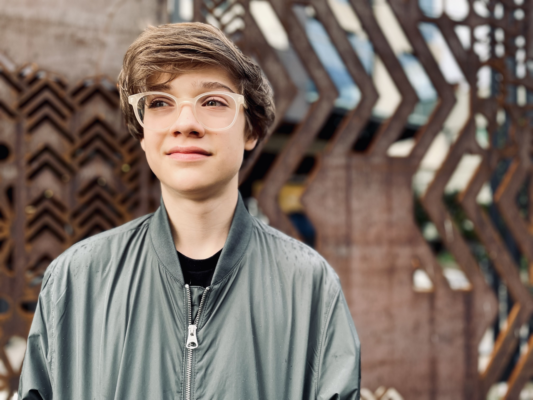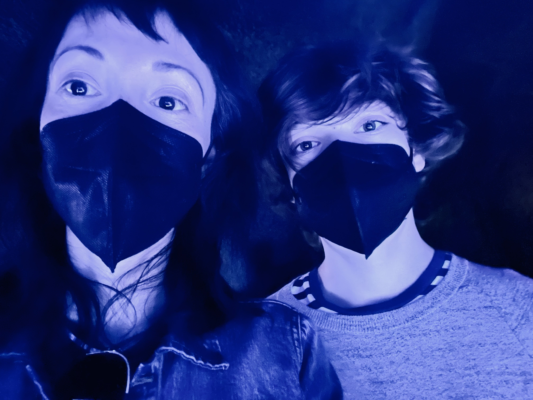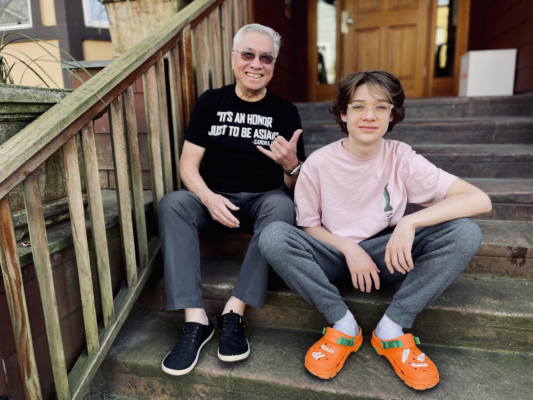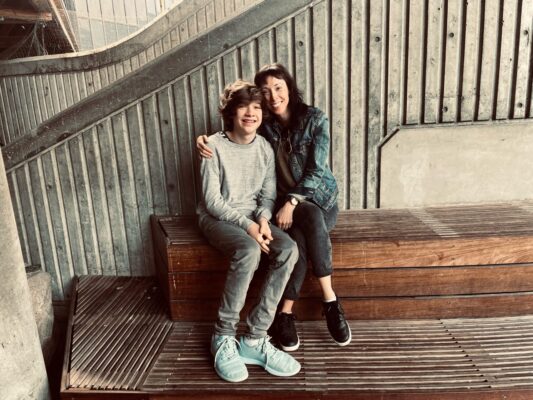
My mother and I look surprisingly different. Her skin is a couple of shades darker than mine, she has dark hair and dark brown eyes. She is half-Chinese and half-White.
This story is about the experience of three generations of my family–me, my mom, and my grandfather who is fully Chinese. I am the first Leong to be born in the continental United States. Both my mom and my grandfather were born and raised on O’ahu in Hawaiʻi.
When I was very little, my mom said when she took me to the pediatrician, the staff often asked her who she was in relation to me. When she told them she was my mother, they were usually taken aback.
Throughout my life, I have never looked clearly Asian like my mom. When someone asks about my last name, they are usually shocked or they completely do not believe me that I am Chinese.
When I was interviewing my mother for this story, I mentioned our differences in looks, and her response was the opposite of what I thought she would say. She said that she thinks that as I get older, our faces are looking more alike. And then she asked me, “Do you still think we look really different?”
This question caught me off guard because I have never really paid attention to how my mother and I look more similar as I age. I have been stuck on seeing us as different.
Recently, my mother visited Hawaiʻi and spent time with my great aunt and uncle.
When she was showing her Auntie Eleanor pictures of me, my Korean great-aunt said, “Oh, he’s such a handsome, hapa boy.”

I thought that was interesting, since most people I’ve talked to don’t see me as “hapa” (someone who is partially of Asian/Pacific Islander descent) at all. It turns out that someone who lives in Hawaiʻi and is immersed in Asian culture can see my mixed-race identity clearly. After hearing about my great aunt’s comment, I felt comforted that someone could see my full self.
One thing I now realize is that my mother’s experiences with race and culture are influenced by me. Through parenting a Caucasian-appearing child while surrounded by a mixed-race and Asian community, her thoughts about race have evolved through her experiences with me.
In 2003, before I was born, my mother did a journalism project interviewing and photographing biracial and bicultural Americans. She told me “I’ll never forget what one person said. She said, ‘It’s like, you can kind of fit in everywhere and nowhere, all at once.’”
I asked my mother if she ever feels like the latter—not being able to fit in 100% in the White or Asian community since her blood is split in between.
“Absolutely,” she said. “Growing up back home in Hawaiʻi, I had a complicated relationship to my Whiteness.”
My mom explained that even though Whiteness can be looked down upon in Hawaiʻi, people like her who are half-White and half-Asian are seen as this exotic, desirable thing. “It doesn’t make sense,” she said.
When I talked with my grandfather, who is completely Chinese and lived in Hawaiʻi until the age of 42, he agreed that the locals of Hawaiʻi can have a problematic view of Whiteness.
In Hawai‘i, people of color, mostly Asians, make up the majority of the population. In contrast, the continental U.S. has a majority White population.

He explained that he and the other locals felt resentment towards the White people who moved to or visited the islands.
“Hawai‘i is a small place and, to some degree, small-minded,” my grandfather said.
Hawaiʻi has the reputation of being a ‘melting pot,’ so I already knew that there are a lot of different cultures and mixed-race people who live there, but I did not know that there was antipathy toward non-locals.
For my mom, growing up in Hawaiʻi, part of her worried that she didn’t feel like a true local because she is half-White. But when she moved to Bellevue, Washington when she was in elementary school, she said she felt like an alien.
Bellevue at that time was mostly White, and my mom and her family were one of the only mixed-race families. “It was so clear that we were not of that place. [Bellevue] I felt too Asian on the mainland, and then not Asian enough back home in Hawai‘i,” she said.
I was intrigued to see what my mother and grandfather had to say when I asked them this: “What is your first memory of race?”
For my grandfather, he talked about his teen years growing up in Hawai‘i. “We saw those mainlanders either coming to visit or moving to the islands as…outsiders,” he said. “To some degree, we’re kind of isolated by the Pacific Ocean and we grew up with that mentality–that small town mentality, that it’s us against them.”
But this idea wasn’t permanent. My grandfather married my grandmother, a White woman from Seattle. A while later in the 80s, when my mom and her sister were young, the family moved to Washington, but my grandfather admits he still had that feeling of disdain for a few more years. Eventually, his attitude began to shift.
“It’s taken me fifty to sixty years to finally come to that realization–how my views towards race were bigoted,” my grandfather said. “It took living here [in Washington] a while to have a broader view that I’m a part of something bigger than just Hawai‘i–I’m a part of the United States and the rest of the world as well.”
For my mom, when I asked her about her first memory of race, she turned the conversation back to me. She told me that when I was in kindergarten, there was a girl in my class who I said I really loved. Apparently, I would draw her pictures and “little Valentines.” When my mother asked me what I liked about her, I said, “Well, she’s Chinese, and I’m Chinese.”
It sounds cute and dumb, but to my mother it meant a lot. At the time I was so little, so my mom had never talked to me about race at all. When I told her this, it was a relief for her because it showed that I was embracing my Chinese culture. She was worried that I might have strayed away from it since I am only a quarter and I’m the first in the family to be born outside of Hawaiʻi.
For the last few years, on official tests and surveys, I’ve been checking the “Caucasian” box instead of “mixed-race.” We didn’t have to mark an identity on tests like this when I was in elementary school, but if we did, I probably would have checked the “Asian” box as well as the “Caucasian” one.

Now that I am in high school, I feel that I am reconnecting with my Chinese identity. One way I’m thinking about that is by showing more of who I am in the boxes I check.
I have never been one to talk much about the subject of race, but through reporting this essay, I learned a lot and it inspired me to share my story.
I have been surrounded by completely different communities in school throughout my whole life. Through second grade, my classmates and friends were mostly Asian. This only lasted until my mom and I moved to a new apartment and I had to switch schools. The difference in racial diversity hit me like a truck. Then, my middle school was more diverse but still predominantly White, like my current high school. Meanwhile, I go home to my mixed-race family every day.
At my first school, I was so young, I was blind to race. I fit in, even if I didn’t look like a lot of the other Asian kids. I didn’t realize it at the time, but nearly all of my friends were Asian. I didn’t realize that most of the kids I hung out with looked different than me.
While I barely understood the concept of race in elementary school, I could still see the difference between my two schools. It was strange, but it didn’t distress me and I was easily able to mold into a new community. It is as if I had the opposite experience of my mother–I was able to fit in comfortably whether it was a predominantly Asian school or predominantly White.
In middle school, I started to notice that people were only seeing me as White. Other kids, even my friends, didn’t believe me when I first told them I was a quarter Chinese. I didn’t feel like I was losing my connection to Chinese culture, but looking back on it, I can see that I was. After being surrounded by a White community for many years, I began to identify as fully Caucasian myself. After a while, I stopped telling people I was Chinese entirely. Not because I was embarrassed, but because that’s just not how I felt. And it is how I was perceived.
Now that I am in high school and finding myself, I am restoring my connection to my culture. I understand that I am mostly White, but that doesn’t mean I should reject a quarter of who I am.
Finn is a high school student at Lincoln High School. He was a fellow in the 2023 pilot Story Gathering Workshop, a program that gave twelve students the opportunity to write and publish an article for our news outlet, Voices.

Be a part of our movement to share and celebrate the diverse stories of our ethnic communities
Our Northwest cultural communities have powerful stories to tell. Your support can help us amplify these voices. Donate $5 or $10 today and follow us to stay connected with the latest updates.